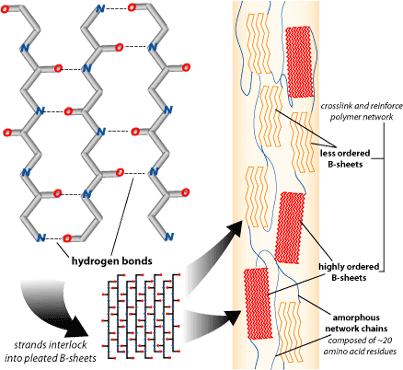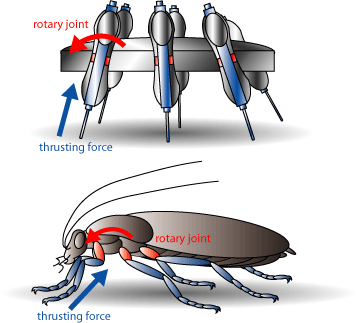BIOMIMICRY/BIMIMETICS: GENERAL PRINCIPLES AND PRACTICAL EXAMPLES
(August 2004)

Design solutions can draw inspiration from many sources, including the anatomy, physiology, and behaviour of living systems. For instance, many Aboriginal Alaskans stalk seals in a similar fashion to the way polar bears hunt the smaller marine mammals [1]. Industry also imitates nature: Joseph Paxton used the structure of a lily pad as inspiration to design the Crystal Palace in 18512, and it is well-known that the Wright brothers were avid bird watchers, and their airplane wing design was modeled after birds [1]. In recent times, scientists have begun to take more ideas from nature, as was common prior to the industrial revolution, now more than ever with the explosion in biotechnological progress. Biomimetics is currently being used to explore a variety of design projects, including the development of different biomaterials (most notably spider silk) as well as robots based on animal models.
Scientists have recently coined some names for the specific use of nature as inspiration in design. In the 1960’s Jack Steele, a researcher with the United States Air Force, coined the word “Bionics,” referring to copying nature, or taking ideas from nature [2]. More recently, the process of drawing inspiration from nature for manmade design has been interchangeably designated biomimicry or biomimetics. Biomimicry (from bios, meaning life, and mimesis, meaning to imitate) refers to studying nature’s most successful developments and then imitating these designs and processes to solve human problems. It can be thought of as “innovation inspired by nature.” [1] Many successful businesses have subscribed to this way of thinking. Darcy Winslow, General Manager of Environmental Business Opportunities for Nike Incorporated, states that “Biomimicry still requires exploration, innovation and creativity, but by thinking like or working with a biologist we must learn to ask a different set of questions and look to nature for inspiration and learning opportunities” [3]. Some of the underlying principles of this problem-solving processes have been recently compiled, and given the moniker of a new field of science.
Biomaterials
One major application of biomimetics is the field of biomaterials, which involves mimicking or synthesizing natural materials, and applying this to practical design. There are many examples of materials in nature that exhibit unique useful properties. One of the major advantages of biomaterials is that they are normally biodegradeable. In addition, the extreme temperatures and hazardous chemicals often used in manmade construction are usually unnecessary with natural alternatives4.
Spider silk is one of the most sought after biomaterials, gaining a reputation as the “Holy Grail” of biomaterials. This material, produced by special glands in a spider’s body, has the advantage of being both light and flexible, and pound for pound is roughly three times stronger than steel: the tensile strength of the radial threads of spider silk is is 1,154 Mpa while steel is 400 Mpa [5]. The web is composed of two types of silk, the major ampullate silk, which forms the dragline and web frame, and the viscid silk, which forms the glue-covered catching spiral [6].
For a flying insect to be caught, the spider’s web must slow its motion to a halt by absorbing kinetic energy. The force required to stop the insect’s motion is inversely proportional to the distance over which the motion must be stopped [6]. The longer the distance over which the insect is slowed down, the smaller the force necessary to stop it, reducing the potential for damage to the web.
The incredible properties of spider silk are due to its unique molecular structure(Fig. 1). X-ray diffraction studies have shown that the silk is composed of long amino acid chains that form protein crystals. The majority of silks also contain beta-pleated sheet crystals that form from tandemly repeated amino acid sequences rich in small amino acid residues [6]. These amino acid sequences are composed of an 8-10 residue poly-alanine block and a 24-35 residue glycine-rich block. The resulting beta-sheet crystals crosslink the fibroins into a polymer network with great stiffness, strength and toughness. This crystalline component is embedded in a rubbery component that permits extensibility, composed of amorphous network chains 16-20 amino acid residues long6. It is this extensibility and tensile strength, combined with its light weight, that enable webs to prevent damage from wind and their anchoring points from being pulled off.

Despite the high demand for spider silk as a building material, the difficulties surrounding its harvest have precluded large scale production. A new biotechnology firm in Quebec, Nexia Biotechnologies, has successfully expressed the silk genes of two spider species in the milk of a transgenic goat [7]. The scientists expressed the genes, found by researchers at the University of Wyoming, using somatic cell nuclear transfer (the process used in mammalian cloning). Also, the manner in which mammary glands create the long amino acid chains found in milk enables the formation of spider silk 8. Afterwards, the silk can be precipitated from the milk, and the result is a web-like material called Biosteel [7]. This technology could have applications in the field of medicine, as a new form of strong, tough artificial tendons, ligaments and limbs. Spider silk could also be used to help tissue repair, wound healing and to create super-thin, biodegradable sutures for eye or neurosurgery, as well as being used as a substitute for kevlar [1].
Robotics
A second application of biomimetics is the field of robotics. Animal models are being used as the inspiration for many different types of robots. Researchers closely study the mechanics of various animals, and then apply these observations to robot design. The goal is to develop a new class of biologically-inspired robots with greater performance in unstructured environments [9], able to respond to changing environmental factors such as irregular terrain. Unlike traditional science fiction views of robots that closely resemble animals in outward appearance, today’s researchers normally study one or more parts of an animal, in order to gain a working knowledge for a specific function. One example is to mimic the leg and joint structure of animals for use in robot mobility. A current collaboration among robotics and physiology researchers at Stanford, U.C. Berkeley, Harvard and Johns Hopkins Universities involves modelling the joint and leg structure of the cockroach for the development of a hexapedal running robot. They studied the ground reaction forces in cockroach locomotion, the direction of these forces relative to the hip joints, and the different movements of the individual legs [9].
These researchers have used biomimicry of the cockroach, one of nature’s most successful species, to design and build sprawl-legged robots that can move very quickly (up to five body-lengths per second)(Fig. 2). In addition, these robots are very good at manoeuvring in changing terrain, and can continue forward motion when encountering hip-height obstacles or uphill and downhill slopes of up to 24 degrees [9]. These types of small, fast robots could potentially be used for military reconnaissance, bomb defusion and de-mining expeditions.

Biomimetic robots are even being considered by NASA’s Institute for Advanced Concepts for use in exploring the planet Mars. While these ideas are only in the brainstorming phase, many researchers believe that only robots designed based on insect models would be able to generate enough lift in Mars’ low-density atmosphere to take off, hover and land to explore the Red Planet [10]. However, one must bear in mind that the fluid dynamics of small insects are very different from that of large robots. Since tiny organisms interact with their fluid environment at different Reynold’s numbers (a value indicating the viscosity of the fluid relative to the size of the organism), the air through which they fly is relatively more viscous than it would be for a larger organism, like swimming through molasses as opposed to water [4]. As a result, one cannot be certain that a large scale model of insect flight would be able to interact with the air in the same way as a real insect to enable flight (this problem would also be worsened by the thin atmosphere on Mars).
Conclusion
Biomimetics or biomimicry is a useful tool in the design process. In its current incarnation it allows present and future designers a modern approach to the ancient practice of imitating nature.
Work Cited
1. Benyus, Janine M. Biomimicry : Innovation Inspired by Nature. Morrow, New York (1997).
2. Centre for Biomimetics (website). School of Construction Management and Engineering.The University of Reading, Whiteknights, England. (2003).
3. Buckminster Fuller Institute (website). Biomimicry. Sebastopol, CA. (2003). www.bfi.org
4. Demont, E. (Personal communication). Biology Professor, St. Francis Xavier University, Antigonish, NS. (2003).
5. Vogel, Steven. Comparative Biomechanics : Life’s Physical World. Princeton University Press, Princeton, NJ. (2003).
6. Gosline J. M., Guerette P. A., Ortlepp C. S. & Savage K. N. The Mechanical Design of Spider Silks: From Fibroin Sequence to Mechanical Function. The Journal of Experimental Biology 202, 3295-3303 (1999)
7. Atkins, E. Silk’s secrets. Nature (news and views). (424). 28 Aug 2003. p 1010.
8. Lazaris A, Arcidiacono S, Yue H, Jiang-Feng Z, Duguay F, Chretien N, Welsh EA, Soares JW, Karatzas CN. Spider Silk Fibers Spun from Soluble Recombinant Silk Produced in Mammalian Cells. Science 295, 472-476 (2002).
9. Clark JE, Cham JG, Bailey SA, Froehlich EM, Nahata PK, Full RJ, Cutkosky MR. Biomimetic Design and Fabrication of a Hexapedal Running Robot. IEEE International Conference on Robotics and Automation. (2001).
Hoversten, P (website). Animal-Like Robots Could Explore Planets. Washington Bureau Chief, Spacenews. Springfield, VA. (2000). www.space.com
(Art by Jen Philpott)